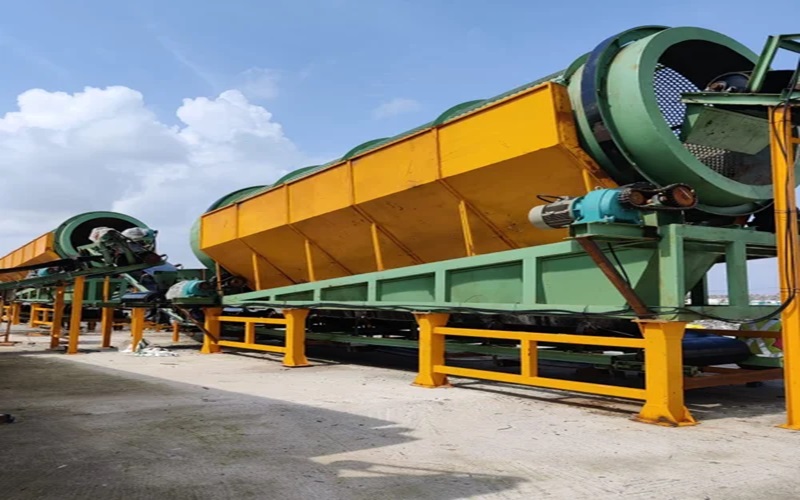Screening Machine with Conveyor for processing Municipal Waste

Using a screening machine with a conveyor for processing municipal waste is a common and effective approach in waste management facilities. This equipment combination helps in the sorting and separation of different components of municipal solid waste (MSW), making it more manageable for further processing and disposal.
How the screening machine with conveyor works in the context of processing municipal waste:
1. Conveyor System:
A conveyor system is used to transport the municipal waste from one point to another within the waste processing facility.
It helps in the continuous and efficient movement of waste, allowing for easy feeding into subsequent processing equipment.
2. Screening Machine:
A screening machine, often equipped with rotating screens or vibrating screens, is employed to separate the waste into different fractions based on size.
The screens have specific hole sizes, allowing smaller particles like organic matter, sand, and fine materials to pass through while retaining larger items.
3. Sorting and Separation:
The screening process helps in the initial separation of municipal waste into different categories, such as organic waste, plastics, paper, glass, metals, and other recyclables.
Oversized items, such as large pieces of wood or bulky materials, may be separated during this stage.
4. Removal of Fines:
Fines, which are small particles and dust, may be generated during the screening process. Some screening machines include features to remove these fines from the material flow.
5. Conveying sorted material:
After the screening process, the sorted materials are conveyed to specific areas or equipment for further processing or disposal.
Different conveyor belts may be used to direct specific fractions (e.g., recyclables) to dedicated processing lines.
6. Additional Sorting and Processing:
The screened and sorted materials can then undergo further sorting processes to enhance the purity of recyclables.
Magnetic separators, eddy current separators, and manual picking stations may be employed to extract metals and other valuable materials.
7. Waste-to-Energy (WTE) Processing (Optional):
In some cases, the screened waste may be directed to waste-to-energy facilities for incineration, where heat is generated and converted into electricity.
Benefits of Screening Machine with Conveyor:
- Efficiency: continuous and automated operation ensures efficient waste handling.
- Sorting: effective separation of recyclable materials from non-recyclables.
- Resource Recovery: Enables the recovery of valuable materials from the waste stream.
- Reduced Landfilling: Enhances waste diversion efforts by diverting materials from landfills.
- Environmental Impact: Contributes to sustainable waste management practices by promoting recycling and resource conservation.
Importance of Screening in Municipal Waste Management
Screening plays a vital role in municipal waste management by separating different types of waste materials based on size, shape, and composition. By using screening machines, large chunks of waste can be broken down into smaller pieces for further processing. This not only helps in reducing the volume of waste but also improves the efficiency of subsequent treatment processes.
Different types of screening machines are used for municipal waste management depending on various factors, such as capacity requirements and specific needs. Some common types include trommel screens, vibrating screens, and rotary screens. These machines utilize different mechanisms to effectively separate the desired fraction from the rest.
Using a screening machine with a conveyor in municipal waste processing is its ability to automate the sorting process. The machine combines both functions—screening and conveying—into one system, eliminating manual labor and ensuring continuous operation.
The integration of a conveyor belt allows for seamless transfer of screened material to subsequent stages without any interruption or need for additional handling equipment. This not only saves time but also reduces labor costs associated with manual sorting operations.
A screening machine with a conveyor offers flexibility in adjusting screen sizes according to specific requirements. Different fractions can be easily segregated by changing screen mesh sizes within minutes. This adaptability enhances overall efficiency while minimizing waste.
Types of Screening Machines Used for Municipal Waste Management
Trommel Screen: This machine consists of a cylindrical drum that rotates as waste material is fed into it. The rotation helps to break up large pieces of waste and allows smaller particles to pass through the screen openings. Trommel screens are ideal for separating organic matter from other types of waste.
Vibrating Screen: This operates by vibrating a mesh or perforated plate to separate materials based on size. Vibrating screens can be customized with different mesh sizes and configurations to achieve specific separation goals.
Conclusion
In this rapidly evolving world, efficient waste management has become crucial for the health and well-being of our communities. Municipal waste processing plays a vital role in tackling the ever-increasing waste generated by cities. And when it comes to achieving effective waste management, screening machines with conveyors are proving to be game changers.
By incorporating a screening machine with a conveyor into the municipal waste processing workflow, organizations can streamline their operations and enhance productivity. These machines not only improve efficiency but also help in sorting out different types of waste materials effectively.